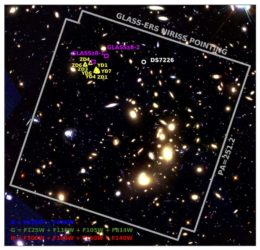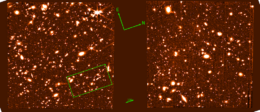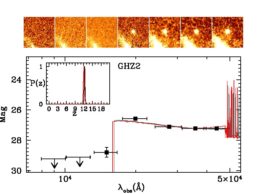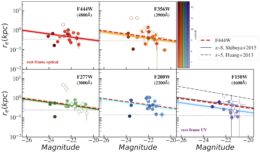After years of anticipation, JWST is operating beautifully, and the results are starting to roll in. Today marks the publication of a new focus issue of the Astrophysical Journal Letters, in which researchers describe the first results from the Grism Lens-Amplified Survey from Space (GLASS) Early-Release Science program. The observing program, led by Tommaso Treu from the University of California, Los Angeles, aims to illuminate the epoch of reionization: the period when the first stars ignited, ionizing the universe’s opaque neutral gas and allowing light to shine through.
The details of reionization, including when it started, when it ended, and what the primary sources of ionization were, are difficult to determine, requiring observations of galaxies less than a billion years after the Big Bang. In addition to exploring this crucial phase in our universe’s history, GLASS-JWST will also study gas in and around galaxies, helping researchers understand how star formation and galaxy structures have evolved over time.
To achieve these goals, GLASS-JWST uses JWST’s Near Infrared Imager and Slitless Spectrograph (NIRISS), Near Infrared Camera (NIRCam), and Near Infrared Spectrograph (NIRSpec) to observe distant galaxies behind the galaxy cluster Abell 2744, which is located about 4 billion light-years away. Why search for galaxies behind a galaxy cluster? The concentrated mass of the cluster bends and magnifies the light from more distant sources — a phenomenon called gravitational lensing — allowing us to study galaxies that would otherwise be out of reach. The Abell 2744 field has been studied in depth as a Hubble Frontier Field, and the GLASS-JWST observations deepen our understanding of this region. The first five articles of the GLASS-JWST focus issue were published today, with 12 more articles to follow.
A High-Redshift Search

This representative-color image combines new observations with JWST and previous observations with the Hubble Space Telescope. The two high-redshift galaxies confirmed in this work are marked with magenta squares. [Roberts-Borsani et al. 2022]
Many searches for high-redshift galaxies rely on identifying prominent emission lines, but these spectral features are weakened from absorption by the neutral hydrogen gas present early in the epoch of reionization. As a result, high-redshift galaxies identified through spectral features in this time period are biased toward those with exceptionally bright emission lines. In order to identify galaxies more typical of this epoch, Roberts-Borsani and collaborators searched for continuum emission from highly lensed galaxies using 15 hours of NIRISS observations. Ultimately, the team confirmed the detection of two galaxies from that epoch with redshifts z = 8.04 and z = 7.90. The team also made tentative identifications of ultraviolet emission lines redshifted into JWST’s observing range, the presence of which may indicate low-metallicity star-forming regions or non-thermal photon sources.

Reduced image of the field (split into module b, left, and module a, right) in the F444W filter, the reddest of the NIRCam wide-band filters. [Adapted from Merlin et al. 2022]
Image Reduction and Catalog Production
Emiliano Merlin (Italy’s National Institute for Astrophysics — Astronomical Observatory of Rome) and collaborators described their efforts to process and make available the NIRCam observations of Abell 2744. The observations, which are centered on the galaxy cluster, consist of images taken in seven filters from 0.9 to 4.4 microns.
In preparation for their planned photometric analysis, the team generated synthetic images from mock galaxy catalogs and used these images to test their image reduction pipeline, which is a customized version of the official JWST pipeline provided by the Space Telescope Science Institute. Ultimately, the team extracted 6,368 sources from the images and measured colors and fluxes for each source, all of which have been made publicly available along with the processed images.
Distant Galaxy Candidates

Photometry and best-fitting spectral energy distribution for the galaxy candidate at z = 12.2. The images across the top of the plot show the source in the seven wide-band NIRCam filters. [Adapted from Castellano et al. 2022]
In total, the team identified six potential galaxies with redshifts in the z ~ 9–15 range. Two sources with redshifts of z = 10.6 and z = 12.2 were found to be especially intrinsically bright, with high rates of star formation. The remaining candidates, which were placed at slightly lower redshifts, were identified less robustly, and the authors note that spectroscopic followup and further deep imaging is needed to make a final identification.
From Reionization to Cosmic Noon
The penultimate article of those released today explores a galaxy somewhat less remote, situated in the star-formation heyday of z ≅ 1–3. A team led by Xin Wang (University of the Chinese Academy of Sciences; Chinese Academy of Sciences; California Institute of Technology) used JWST’s high-resolution spectroscopic capabilities to investigate a redshift z = 3.06 galaxy in detail, mapping the properties of its gas as a function of location within the galaxy.
This set of observations — the first instance of using JWST’s slitless spectroscopy to obtain spatially resolved observations of a high-redshift galaxy — allowed the team to measure the galaxy’s star-formation rate, metallicity, and extinction. The team found that the galaxy’s metallicity gradient is inverted, meaning that the galaxy’s outskirts contain more metals than the galactic center. This suggests that a past interaction between the target galaxy and a nearby galaxy that’s 100 times more massive caused metal-poor gas from the galaxy’s outer regions to be funneled in toward the center.

Maps of the galaxy GLASS-Zgrad1 constructed from JWST NIRISS observations. [Adapted from Wang et al. 2022]
A Visual-Wavelength View of Galaxy Sizes
Finally, Lilan Yang (University of Tokyo) and collaborators investigated the size–luminosity relation for galaxies with redshift z > 7. While the Hubble Space Telescope has allowed researchers to measure the sizes of distant galaxies at rest-frame ultraviolet wavelengths, the size–luminosity relationship at rest-frame optical wavelengths has been more difficult to determine.

Size–luminosity relationships for galaxies observed in five NIRCam wavelength bands. The solid and dot-dashed black lines in the rightmost panel (F150W) show the results from previous studies with Hubble data. Click to enlarge. [Yang et al. 2022]
While the first five articles in the focus issue stick close to the stated goals of the GLASS-JWST program, the remaining articles will branch out to explore a wide range of topics — proto-globular clusters in Abell 2744, galaxy shapes during the epoch of reionization, intriguing foreground stars in the Abell 2744 field, and much more. Whet your appetite for early-release science with today’s research articles, and stay tuned for more results from GLASS-JWST!
Citation
“Early Results from GLASS-JWST. I: Confirmation of Lensed z ≥ 7 Lyman-break Galaxies behind the Abell 2744 Cluster with NIRISS,” Guido Roberts-Borsani et al 2022 ApJL 938 L13. doi:10.3847/2041-8213/ac8e6e
“Early Results from GLASS-JWST. II. NIRCam Extragalactic Imaging and Photometric Catalog,” Emiliano Merlin et al 2022 ApJL 938 L14. doi:10.3847/2041-8213/ac8f93
“Early Results from GLASS-JWST. III. Galaxy Candidates at z ∼9–15,” Marco Castellano et al 2022 ApJL 938 L15. doi:10.3847/2041-8213/ac94d0
“Early Results from GLASS-JWST. IV. Spatially Resolved Metallicity in a Low-mass z ∼ 3 Galaxy with NIRISS,” Xin Wang et al 2022 ApJL 938 L16. doi:10.3847/2041-8213/ac959e
“Early Results from GLASS-JWST. V: The First Rest-frame Optical Size–Luminosity Relation of Galaxies at z > 7,” L. Yang et al 2022 ApJL 938 L17. doi:10.3847/2041-8213/ac8803

